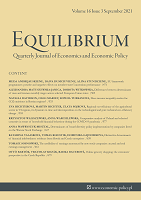Regional eco-efficiency of the agricultural sector in V4 regions, its dynamics in time and decomposition on the technological and pure technical eco-efficiency change
Regional eco-efficiency of the agricultural sector in V4 regions, its dynamics in time and decomposition on the technological and pure technical eco-efficiency change
Author(s): Eva Richterová, Martin Richter, Zlata SojkováSubject(s): Business Economy / Management, Agriculture, Energy and Environmental Studies, Regional Geography
Published by: Instytut Badań Gospodarczych
Keywords: agricultural eco-efficiency; Visegrad regions; Malmquist index; technological change; pure technical eco-efficiency;
Summary/Abstract: Research background: Agriculture plays a vital role in producing food to ensure food security, but it is one of the biggest contributors to environmental pollution. One of the main goals of the new CAP is to set higher ambitions for environmental actions, which brings into the front the concept of agricultural eco-efficiency. The notion of eco-efficiency includes the economic and also ecological dimensions of sustainable agriculture. Purpose of the article: The main goal of this paper is to evaluate the eco-efficiency of agricultural production and its dynamics during the years 2013, 2015, and 2017 of NUTS 2 regions within the Visegrad 4 (V4), i. e. The Czech Republic, Slovakia, Hungary, and Poland. The part of the main goal is to verify the research hypothesis that all the biggest agriculture producers are eco-efficient. Methods: V4 regional eco-efficiency of the agricultural sector is expressed by the Malmquist productivity index and is estimated using the output-oriented Data envelopment analysis (DEA) model, under the assumption of constant return to scale (CRS). The Malmquist index is decomposed to technical eco-efficiency change (EC) and technological change (TC). Based on the eco-efficiency, technological and pure technical eco-efficiency change, V4 regions are classified into three groups: the most progressive regions, the progressive regions, and the regressive regions. Findings & value added: CZ02: Central Bohemia, CZ04: Northwest, HU33: Dél-Alföld, HU31: Észak-Magyarország, HU32: Észak-Alföld, PL21: Malopolskie, PL41: Wielkopolskie, SK01: Bratislava region, and SK02: Western Slovakia have an eco-effective agricultural sector, the remaining V4 regions have eco-ineffective agricultural sector. The research hypothesis that all the biggest agricultural producers are eco-effective is not confirmed. During the analyzed years, 19 V4 regions improve their agricultural eco-efficiency. The main contributor to eco-efficiency improvement is technological progress, which indicates that producers implement innovations that lead to more eco-efficiency agricultural production.
Journal: Equilibrium. Quarterly Journal of Economics and Economic Policy
- Issue Year: 16/2021
- Issue No: 3
- Page Range: 553-576
- Page Count: 24
- Language: English

